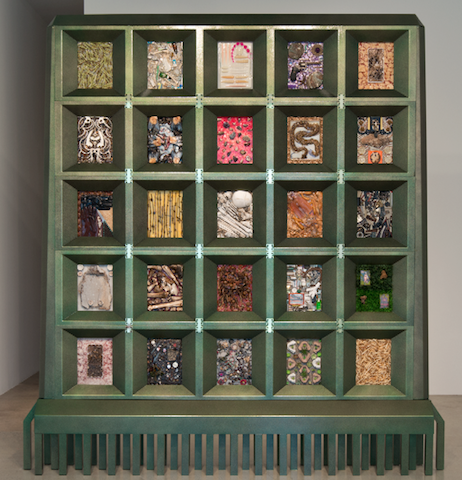Selected by Jonathan Griffin
The first time I saw Max Hooper Schneider’s work was at an art fair on a movie ranch. In a corner of a wooden shack, wet black newts nestled in a model of a woman’s cervix, blue-lit and mist-shrouded in their glass tank. The sculpture, Morphogenesis System: Median Section of Female Pelvis and Fire-Bellied Newt (2014), seemed like a glimpse into the post-human future.
The next time I encountered his work, it was raining so hard in LA that I was afraid to get out of my car. In the Santa Monica Canyon, where Schneider had installed his work, Living Epoxy: Disarticulation of Delphinapterus leucas (2013), in the large-glass-windowed space that sometimes operates as Gallery 169, storm drains chundered deluges of water toward the ocean. It was night, and the work, in the form of glowing blue beluga whale skeleton hung on chains from a metal frame. Schneider showed me a photograph in which the same home-made phosphorescent pigment that he used in this work, had been applied to rocks in the Gobi Desert, and also a tank containing a chrome-plated Buddha’s hand citrus-fruit and live snails.
The title sculpture Schneider recently exhibited at Kayne Griffin Corcoran in Los Angeles, in his exhibition Accidental Menagerie (2015), included no living animals but plenty of dead ones. It looked like a monolith for the end of civilization, adorned with a vertical grid of specimen trays containing such grotesqueries as bones (some human), a dead snake, barbed wire, a revolver, maggots and fish tails, all encased in resin. In an unlit rear gallery, I spent a long time gazing into a plastic hot-tub’s churning black-dyed water trying to confirm a rumour that it contained several large carp. I don’t know whether the shapes that I glimpsed in Blackwater Jacuzzi (2015) were fish or simply the shadows of my darkening imagination.
Schneider is an artist who makes things that would be captivating in any context; in contrast to so many of his peers, he does not make art about art. Perhaps that is because of his background in science and design, or his equal enthusiasms for death metal and arcana, or defunct technology. On Facebook and Instagram, he posts photographs of preposterously ugly dolphins, and messages such as ‘Does anyone know a grey-market pet shop in Paris?’ His living sculptures raise the stakes for both the viewer and the owner. Schneider is fiercely alive to the world, and sensitive to our current moment at both the micro and macro levels. According to his pre-apocalyptic art, we may be at the beginning of the end.
Max Hooper Schneider was born in Los Angeles where he continues to live and work. He studied landscape architecture at Harvard Graduate School of Design, with additional degrees in urban design and biology. He participated in both the 2012 and 2014 editions of Mongolia Land Art Biennial
This article was first published in the January & February 2016 issue of ArtReview.
